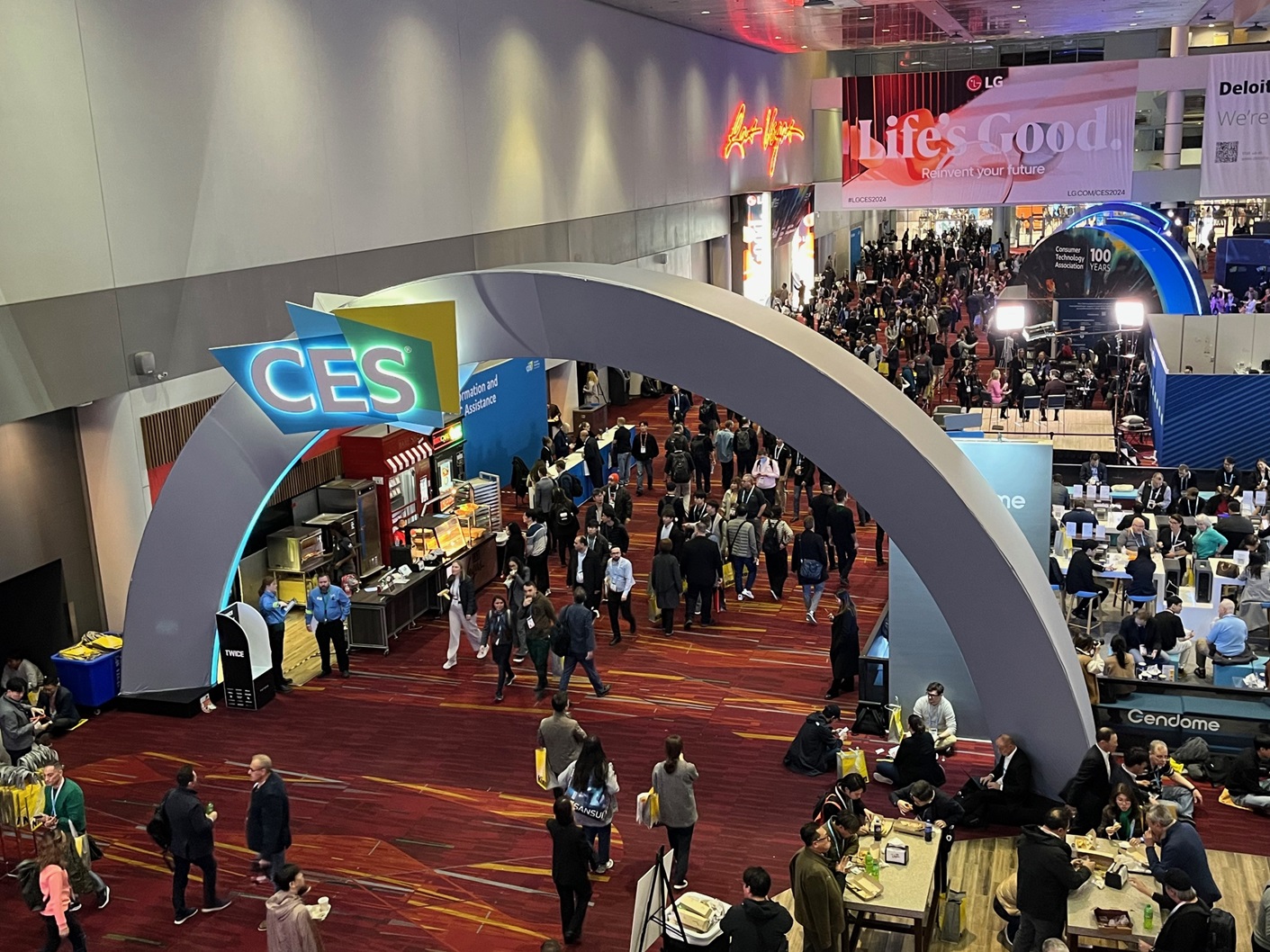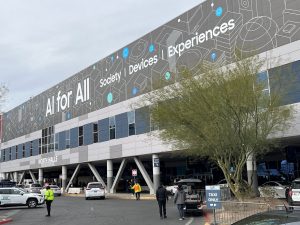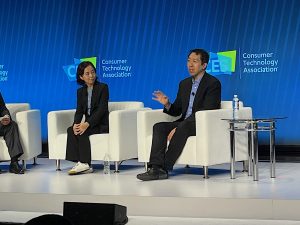 AI
AI
 AI
AI
 AI
AI
The theme for this year’s CES Consumer Electronics Show was “All On.” It could just as easily have been “All AI.”
From the standing-room-only sessions on the topic to a seemingly endless parade of news releases that highlighted artificial intelligence for a wide range of consumer technology offerings, AI dominated the conversation at the industry gathering in Las Vegas this week.
There was no shortage of AI-infused gadgets at the CES 2024 consumer electronics conference. Cookware, sports cameras, shoes and even skin care became AI-driven over the past year. The Bird Buddy smart perch won a CES Innovation Award this week for its use of AI to identify feathered visitors.
“Tomorrow is going to be more intelligent than ever,” Brian Comiskey, director of thematic programs and futurist for the Consumer Technology Association, said during a media briefing in advance of the show. “With AI, it’s honestly going to be everywhere.”
Longtime observers of the tech industry have seen this movie before. The hype cycle surrounding a suddenly popular technology tends to follow a roller coaster of adoption, and more than one prominent scientist has recently predicted the coming of a chilly “AI winter” as enthusiasm fades in 2024.
Yet Andrew Ng (pictured below, right), the founder of Google Brain and one of the AI’s leading figures, took issue with predictions of AI’s demise during an appearance at CES on Tuesday.
“We’re not in for winter,” Ng said. “The business fundamentals of AI are stronger than ever. AI is a general-purpose technology. It’s like electricity.”
If Ng is correct, then AI will need to move beyond bird perches and into the enterprise mainstream. CES offered an opportunity to measure how enterprise use cases for AI are beginning to grow.
Pharmaceutical giant Pfizer Inc. is using AI-powered life science solutions for drug discovery in collaboration with Google Cloud, and it has developed a weather alert for potential migraine attacks using AI to deliver personalized branded notifications to a market 72 hours before a storm.
 Earlier this week, IBM Corp. released its Global AI Adoption Index and reported that 42% of enterprise-scale companies have actively deployed AI in the business, and an additional 40% are currently exploring or experimenting with AI but have not yet deployed models.
Earlier this week, IBM Corp. released its Global AI Adoption Index and reported that 42% of enterprise-scale companies have actively deployed AI in the business, and an additional 40% are currently exploring or experimenting with AI but have not yet deployed models.
“The ability to create big models that can take large amounts of data is a big breakthrough,” Steve Canepa, general manager of Global Industries at IBM, said during a CES panel session. “What is going to happen in 2024 is AI is going to move into the core of the business.”
Major enterprises at CES this week expressed an interest in AI deployment at the edge. To facilitate this, semiconductor firms have been focused on developing powerful, energy-efficient processors that can process AI algorithms within small-footprint devices.
An example of this can be seen in Qualcomm Inc.’s recent announcement of AI-capable Snapdragon chips for smartphones and PCs. The evolving enterprise information technology model will involve a hybrid mix of processors at the edge working in concert with on-premises or cloud-based data centers, according to one Qualcomm executive.
“2024 and beyond is really about scale from an AI perspective,” said Don McGuire, chief marketing officer at Qualcomm, during a CES session on Monday. “The hybrid approach is going to win the day.”
Further evidence for the expansion of AI in the enterprise can be seen within the semiconductor industry itself. The recently introduced CoPilot generative AI tool from Synopsys Inc. is being used to design next-generation processors through a collaboration with Microsoft Corp.’s Azure OpenAI service.
Syed Alam, global semiconductor lead and managing director at Accenture Plc, has been tracking the use of AI within the semiconductor industry and observed an increase in adoption of AI tools as demand for the technology has exploded over the past year.
“It’s starting to grow quite a bit,” Alam said in an exclusive interview with SiliconANGLE. “Think about this: AI is designing chips for AI.”
Despite technological advancements in the use of AI, there are still concerns that its widespread deployment could lead to significant issues down the line. One of these involves the use of improperly licensed content to train AI models, a concern that has received additional focus in recent weeks following a copyright infringement lawsuit by the New York Times against ChatGPT developer OpenAI.
At CES this week, Getty Images launched GenerativeAI by iStock, a tool for small businesses and enterprise software developers to use content and proprietary data from Getty’s library. It was built using Nvidia Corp.’s Picasso, a foundry for custom AI models, and was designed to provide a commercially safe way for generating visuals.
“Yes, there’s a lot of issues around trust,” said Richard Kerris, vice president of Omniverse Platform Development and general manager at Nvidia. “That absolutely has to be addressed.”
Another issue surrounding the growing use of AI is job loss. A November survey by ResumeBuilder found that 37% of companies using AI replaced workers with the technology, and 44% of responding firms indicated that AI will lead to layoffs in 2024.
“The saying is you’re not going to be replaced by AI, but you are going to be replaced by someone who knows how to use AI,” said Leslie Shannon, head of trend and innovation scouting at Nokia Corp.
Against this backdrop of concerns, AI is still poised to make several important leaps forward in 2024. One of these will likely involve advances in the pixel space, according to Fei-Fei Li (below, left), former chief scientist of AI and machine learning at Google Cloud and co-director of the Human-Centered Artificial Intelligence Institute at Stanford.
 There are already examples of how pixel generation is rapidly advancing. One can be seen in the use of DALL-E in Microsoft Designer to facilitate generation of unique images by writing an AI image prompt.
There are already examples of how pixel generation is rapidly advancing. One can be seen in the use of DALL-E in Microsoft Designer to facilitate generation of unique images by writing an AI image prompt.
“I do think we’re at the verge of very exciting advances in the pixel space,” Li told the CES audience. “It’s going to be more pixels first, just language-induced.”
In a joint appearance with Li, Ng offered his belief that the coming year will also see a rise in autonomous agents, an ability to perform tasks without having to write out the steps first.
“It plans out a sequence of actions, like ‘Do these web searches and download these web pages’… and comes back to me with an answer,” Ng explained. “I feel like there is a lot of traction for breakthroughs in the coming months.”
The multitude of sessions and product announcements involving AI at CES this week underscored the hype surrounding a technology that has become a marketing slogan as much as a tool for business growth. During her CES appearance, Li cautioned that the tech world needed to take the time to fully understand AI and the science behind it.
“Every AI today is called generative AI… that is an overblown word,” Li said. “We really should peel away from the hype and understand what this technology can do.”
THANK YOU